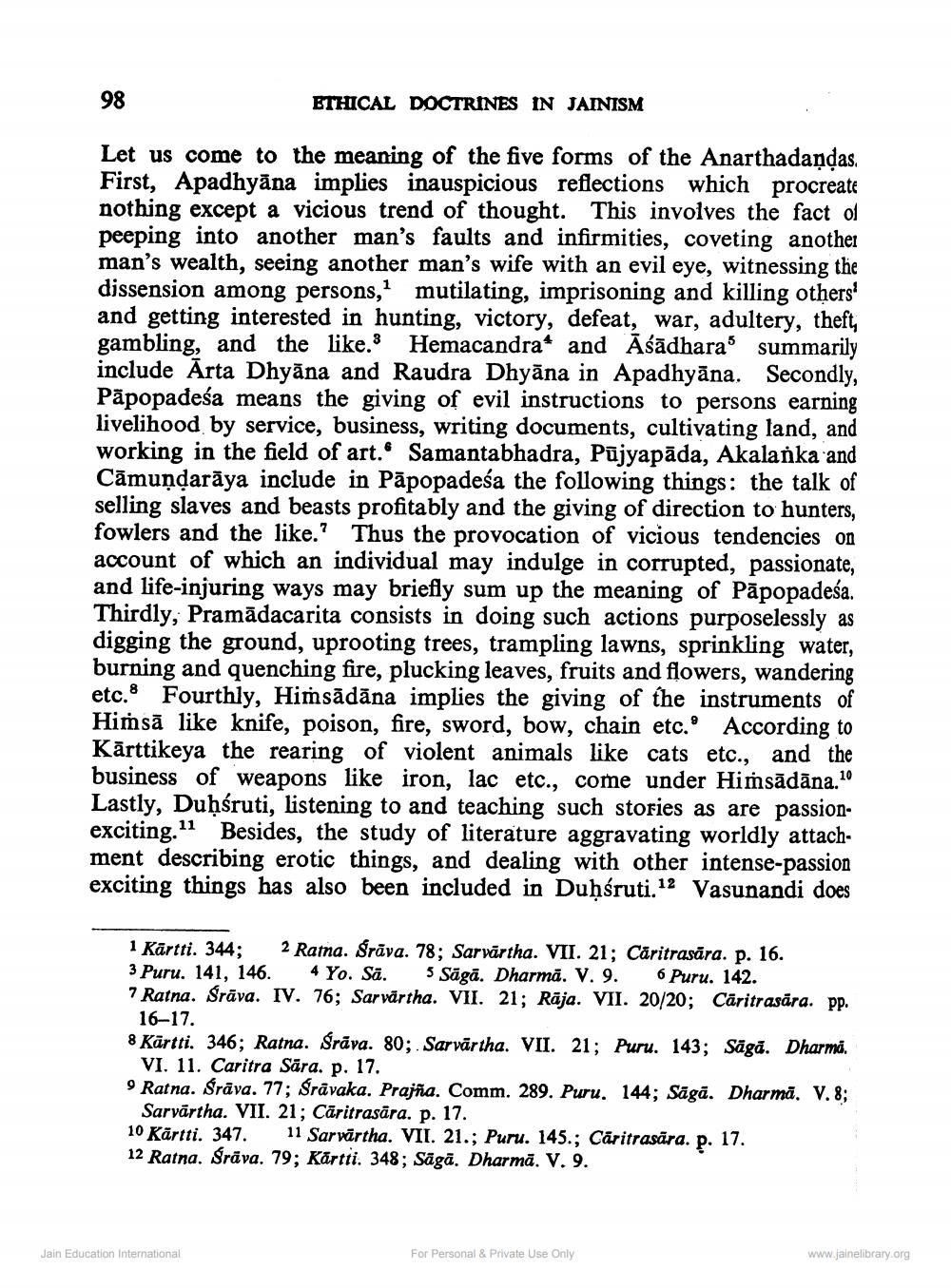________________
98
ETHICAL DOCTRINES IN JAINISM
Let us come to the meaning of the five forms of the Anarthadaņdas. First, Apadhyāna implies inauspicious reflections which procreate nothing except a vicious trend of thought. This involves the fact of peeping into another man's faults and infirmities, coveting another man's wealth, seeing another man's wife with an evil eye, witnessing the dissension among persons, mutilating, imprisoning and killing others' and getting interested in hunting, victory, defeat, war, adultery, theft gambling, and the like. Hemacandra* and Āśādhara summarily include Arta Dhyāna and Raudra Dhyāna in Apadhyāna. Secondly, Pāpopadeśa means the giving of evil instructions to persons earning livelihood by service, business, writing documents, cultivating land, and working in the field of art. Samantabhadra, Pūjyapāda, Akalanka and Cāmuṇdarāya include in Pāpopadeśa the following things: the talk of selling slaves and beasts profitably and the giving of direction to hunters, fowlers and the like.? Thus the provocation of vicious tendencies on account of which an individual may indulge in corrupted, passionate, and life-injuring ways may briefly sum up the meaning of Pāpopadeśa. Thirdly, Pramādacarita consists in doing such actions purposelessly as digging the ground, uprooting trees, trampling lawns, sprinkling water burning and quenching fire, plucking leaves, fruits and flowers, wandering etc.8 Fourthly, Himsādāna implies the giving of the instruments of Himsā like knife, poison, fire, sword, bow, chain etc. According to Kārttikeya the rearing of violent animals like cats etc., and the business of weapons like iron, lac etc., come under Himsādāna. 10 Lastly, Duḥśruti, listening to and teaching such stories as are passionexciting. 11 Besides, the study of literature aggravating worldly attachment describing erotic things, and dealing with other intense-passion exciting things has also been included in Duḥśruti."2 Vasunandi does
1 Kārtti. 344; 2 Rama. Śrāva. 78; Sarvartha. VII. 21; Caritrasāra. p. 16. 3 Puru. 141, 146. 4 Yo. Sa. 5 Sāgā. Dharmā. V. 9. Puru. 142. 7 Ratna. Śrāva. IV. 76; Sarvärtha. VII. 21; Räja. VII. 20/20; Caritrasära. pp.
16-17. 8 Kärtti. 346; Ratna. Srāva. 80;. Sarvārtha. VII. 21; Puru. 143; Sagă. Dharma.
VI. 11. Caritra Sāra. p. 17. 9 Ratna. Śrāva. 77; Sravaka. Prajña. Comm. 289. Puru. 144; Sāgā. Dharmā. V.8;
Sarvārtha. VII. 21; Căritrasära. p. 17. 10 Kärtti. 347. 11 Sarvārtha. VII. 21.; Puru. 145.; Caritrasāra. p. 17. 12 Ratna. Śrāva. 79; Kärtti. 348; Såga. Dharmä. V. 9.
Jain Education International
For Personal & Private Use Only
www.jainelibrary.org




